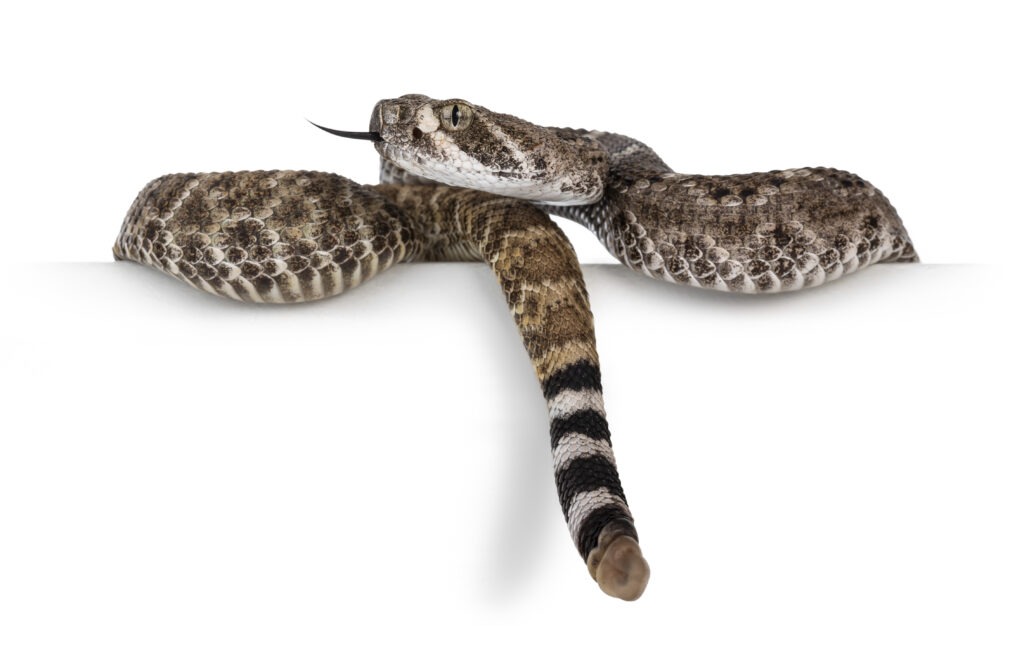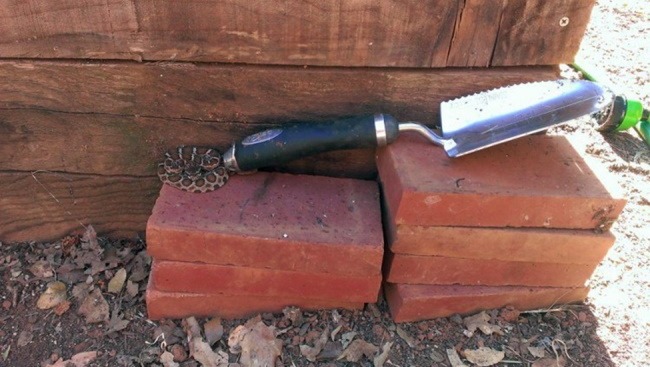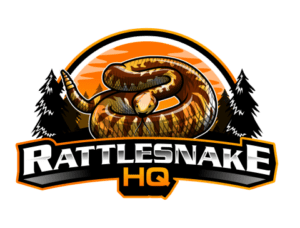

Rattlesnakes are the only snakes that have rattles at the ends of their tails. Adult rattlesnakes have a loud and distinct sound when they rattle, but do baby rattlesnakes rattle?
Here’s what I’ve seen (and heard):
Baby rattlesnakes cannot rattle immediately after being born. They have one rattle segment at birth, often called a birth button, but that lacks the ability to make sound until there are more segments connected to it, which come after the rattlesnakes have shed once or twice.
The first shed typically happens about a week after being born.
The process of a rattlesnake’s rattle growing is fascinating. We’ll get into how many segments they get over the first year, whether you can guess the age of a rattlesnake by the length of its rattle, and if the rattles continue adding segments throughout the adult life of a snake.
Let’s dive in!

How a Rattlesnake Rattle Works
The rattle of a rattlesnake is much more complicated and much more interesting than you might think at first glance.
Many people assume that the rattle is comprised of a hollow tail that is filled with loose segments that rattle around when the rattlesnake shakes its tail. However, that is not the case.
The rattle of a rattlesnake is actually comprised of multiple hollow segments that taper into the next one.
The segments are hard and fit loosely together. When a rattlesnake shakes its tail, the segments rub against each other and make the signature rattling sound.
The rattle of a rattlesnake is made of Keratin, the same material that our fingernails are made out of. However, the Keratin dries out over time and becomes harder, and that helps the rattlesnake’s rattle make the sound that most people fear.
A Baby Rattlesnake’s Birth Button
When rattlesnakes are born, they have a nub at the end of their tail called a birth button.
The way that a rattlesnake goes from having a birth button to a full-grown rattle is quite unique and intriguing. Baby rattlesnakes cannot make sounds when they shake their tail until they have shed a couple of times because they do not have a rattle yet.
The birth button is a nub at the end of a rattlesnake’s tail that will eventually grow to become a rattle.
At birth, it is covered by a rattle cap, but the rattle cap will fall off during its first shed. However, the birth button will not fall off, and it will eventually become the tip of a rattlesnake’s rattle.
If you see a rattlesnake and it attacks without you hearing a rattle, it may still only have its birth button, and can’t rattle. After time passes, the birth button and other segments of the rattle can break and fall off.
It is also possible for a rattlesnake to lose its entire rattle due to injury.
#Ishmael is looking mighty fine this morning, sitting in a sun spot to bask. He might have recently shed. #rattlesnake pic.twitter.com/JG5m5uz5FU
— Timber Tweets (@TimberTweets) August 11, 2017
A Baby Rattlesnake’s First Shed
The first shed of any baby rattlesnake is a benchmark achievement that is a sign that many things are about to happen.
Rattlesnakes typically shed for the first time when they are a week old. When they are a week old, they are able to hunt on their own, their venom has developed, and they will leave the area that they were born in.
Rattlesnakes need at least 2 segments on their rattle in order for it to make any noise. At a week old, the rattle is comprised of the birth button.
However, sometimes it takes 2 sheds for a baby rattlesnake to be able to make the rattling sound, as the button at the ends of their tails does not have a dry second segment yet.
With only two or three segments on their rattle, a young rattlesnake is not able to make a loud rattle sound. It can sound faint and high-pitched, almost like an insect.
Rattlesnake Rattle Additional Segments
Rattlesnakes develop a new rattle segment every time they shed.
Each time a rattlesnake prepares to shed its skin, they also prepare a new rattle segment. The new segment is always at the end of the tail before the rattle. It has live tissue in it while the rest of the rattle is dry, dead segments, similar to the ends of your fingernails. source
Juvenile rattlesnakes will shed more often than fully matured snakes, so their rattles grow a lot faster when they are younger.
When being studied, researchers will sometimes inject acrylic paint into their rattles so they can track their growth from the last time they captured them. This does not hurt the snake because there are no nerves in the rattle.
The rattle basically is just dry, dead skin at the end of a rattlesnake’s tail that they use to warn off predators.
The inside of a Rattlesnake rattle pic.twitter.com/N00cE5pUMy
— mary ( メアリ ) (@uproarinhouston) October 8, 2020
Differences in Rattlesnake Rattle Segments
Not all of the segments on a rattlesnake’s rattle are the same. There are differences in each of the segments, and there are reasons why.
As a rattlesnake gets bigger, its skin is unable to stretch and grow along with it, so it must shed the skin and replace it with a bigger one. Each time the rattlesnake does this, the newest segment on its rattle is bigger too.
This creates a rattle that is tapered from the larger, newer rattle segments, down to the tip of the rattle which is made of smaller, older segments.
Once they are mature and stay at a more consistent size, the rattle will even out a bit more. This is why some rattlesnakes have a tapered rattle, while some others have a wider rattle.
The tapered tip of the rattle has fallen off at some point in time. source
A rattlesnake’s health has an effect on the segments of the rattle. A healthy rattlesnake will produce thick, shiny segments for its rattle. If a rattlesnake is in poor health, the new segments will be thinner and duller.
The quality of the rattle segments can actually tell researchers when a female rattlesnake might be pregnant, or ready to be bred.
#An older diamond back female rattlesnake. Her broken rattle adds alot of character.https://t.co/3fJfIdlCf2 pic.twitter.com/hSymQzhG6Q
— Nature & Animals🌴 (@naturezem) June 26, 2021
When a female snake is pregnant, the nutrients that she would usually keep for herself are redirected to her babies, so the rattle segments from those years would seem slightly more unhealthy than the rest, and are thinner than the others.
Do Rattlesnake Rattle Segments Break Off?
Rattlesnake rattles can break off as the snake gets older. As they age, the longer their rattle gets, and the more likely it is to lose some segments at the end when it brushes against rocks or trees.
While most of the time, you can roughly determine the age of a rattlesnake by the number of segments on their rattle, this is not always the case.
A rattlesnake does not keep all of its rattle segments for its entire life. While segments of their rattle do not fall off during each shedding, they can fall off for a multitude of reasons.
As they get longer, the segment rattles on these snakes become drier. This makes them more brittle and more likely to fall off for any number of reasons.
With the increased brittleness of the rattle, snakes can hit their rattles on rocks or branches when fighting, hunting, or just traveling. If a rattle is already delicate, old, or weak because the snake has been sick, anything knocking against it can result in a few segments falling off and getting lost.
This is not a big deal at all to a rattlesnake, as it does not hurt to lose old segments of a rattle.
It’s similar to cutting your fingernails! The rattlesnake probably won’t even notice that the segments of their rattle have fallen off. As long as it still makes the rattling sound and they can warn predators away from them, they don’t really care.
Rattlesnake Rattle Growth Chart
Tracking a rattlesnake’s age through their rattle is not impossible as some suggest, but it is not a foolproof way to track their age. Segments break off, shedding happens multiple times a year, or their environment changes.
There are many factors that have to be considered when charting the number of segments on a rattlesnake’s rattle increases. Rattle segments often break and fall off, especially the birth button.
| Age of Snake | Number of Rattle Segments |
| Birth | 1 (birth button) |
| 1 Week Old | 2 |
| 2 Weeks Old | 3 |
| 3 Weeks Old | 4 |
| 1 Year Old | 6 |
| 2 Years Old | 9 |
| 3 Years Old | 11 |
| 4 Years Old | 12 |
How a Rattlesnake’s Environment Effects Shedding
The environment of a rattlesnake can influence how often they shed. If the environment is extremely harsh and dry, then they will shed more often because the scales are drier than they should be. When a rattlesnake’s skin becomes damaged, they may need to shed the top layer of scales in order to protect the rest of their scales and make sure that their skin is as healthy as it can be. This means that they will shed more than once a year, and their rattle will develop more than one segment a year.
If their environment is wet instead of dry, then they may shed less than once a year. Their environment will keep their scales moist and if their environment has plenty of healthy green leaves, the rattlesnake’s scales will not suffer a lot of damage, which means that they do not need to shed as often.
How a Rattlesnake’s Age Effects Shedding
When rattlesnakes are young, they shed more often because they grow a lot more than when they are older. As the rattlesnake gets older, they will need to shed less often.
However, towards the end of their lives, if they live 15-25 years, then their scales get weaker, and they will need to shed more often because they need to have tougher scales in order to protect themselves.
The species of the rattlesnake will also change the shedding habits of the snake. Some rattlesnakes need to shed two-three times a year, while others only need to shed once a year, especially after they mature and stop growing.
How a Rattlesnake’s Growth Effects Shedding
Rattlesnakes do most of their growing during the first 2-3 years of their life, and they grow in massive amounts during the first year of their life.
This affects their shedding habits because as a rattlesnake grows, their skin stays the same size and length, so they have to shed it in order to keep growing. So if a rattlesnake is only a few months old, and growing like crazy, it will shed its skin every few weeks.
This means that their rattle will gain many segments during their first few months of life.
Rattlesnakes typically stop growing in length after 2-3 years. However, this does not mean that they do not get thicker. After they are 3 years old, many rattlesnakes will only shed once a year because they are not growing very much and still feel comfortable in the top layer of skin that they currently have.
How a Rattlesnake’s Eating Habits Affect Shedding
The eating habits of rattlesnakes affect how often they shed. If a rattlesnake is consistently eating, then it will shed once or twice a year, depending on the age and breed of the rattlesnake.
When they are fed, they are happy, and they grow. Rattlesnakes eat large meals that take a long time to digest, which means they grow in some way, and are now too big to fit in their skin, so they need to shed it in order to feel comfortable again.
If a rattlesnake is not eating regular meals and has to hunt for a long time in order to find food, then it will not shed as often as a well-fed rattlesnake will.
They are not growing, so they do not need to shed their uncomfortable, ill-fitting skin. It also takes a lot of energy to shed skin, and the rattlesnake may need that energy in order to effectively hunt and find food. A hungry snake means a tired snake.
This also means that their rattle will not gain as many segments as a well-fed snake. The segments may fall off more easily than normal because the segments are drying out and becoming brittle.
Meet the Massasauga Rattlesnake, the snake well known for its distinctive rattle used to warn others. This snake is born with a single segment at the end of its tail. Each time the snake sheds its skin, a new segment is added. These segments then create the rattle. #SnakeSunday pic.twitter.com/EHztO4VUFA
— French River PP (@frenchriverpp) July 14, 2019
Why Rattlesnakes Rattle (and when they don’t)
Rattlesnakes use their rattle as a defensive tactic rather than an offensive one.
When they feel threatened by a predator, rattlesnakes will use their rattle to scare them off. The rattling of their tails is a warning to anything that they feel could hurt them, and they are telling that dangerous thing to back off, or they will hurt them.
However, they may not use their rattle if they feel they do not have time to scare the predator before it is harmed, so they may strike without any warning.
Rattlesnakes don’t always use their rattle.
If they are hunting, they will not use their rattle because they do not want to scare their prey away. If they scare their prey away, they won’t be able to eat and survive. While the rattle of a rattlesnake is one of the attributes that define the species, it is a tool that they instinctively know how to use.
